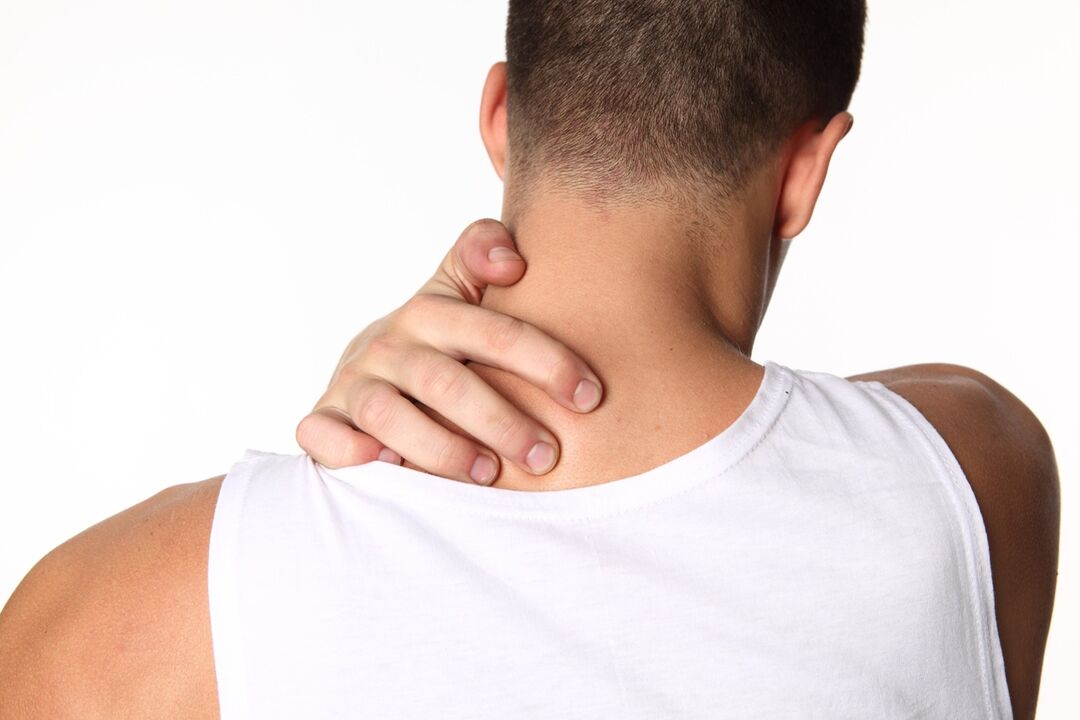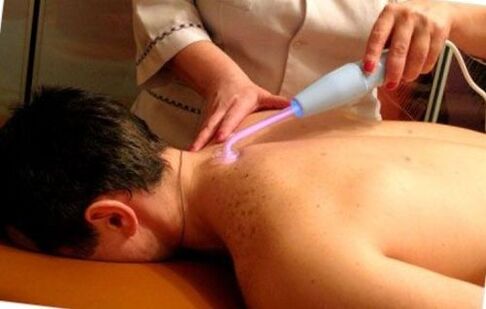
Osteonecrosis is a disease that affects the intervertebral disc and leads to the development of reactive changes in the paravertebral structures. Under the influence of certain factors, the fibrous ring loosens and the nucleus pulposus penetrates into it.
If left untreated at this stage, the pathological process will end with disruption of the annulus fibrosus and disc herniation. This in turn begins to compress the spinal nerves or the spinal cord itself, leading to compression syndrome.
Characteristics and stages of development
A distinctive feature of cervical spondylosis is a rather diverse set of symptoms, including headaches and dizziness, unstable blood pressure, feeling of lack of air, numbness of the upper limbs, etc. v.
All this not only brings significant discomfort to life, but also complicates diagnosis, since a person does not immediately go to a neurologist, but to a cardiologist, orthopedist, and neurologist. figure or therapist. Treatment of cervical spondylosis is prescribed taking into account two factors - physiological, which implies the natural aging of the body, and pathological - the presence of inflammatory or degenerative processes in the patient.
Physiological changes include replacement of the nucleus pulposus by fibrous tissue, and clinical manifestations occur only when the nerve root is irritated. Pathological changes are observed outside the cartilage and are necessarily accompanied by compression of nerve endings and blood vessels. Symptoms are pain in various locations, crunching and crunching when turning the head, muscle weakness or numbness.
The cervical region is the most mobile and is subject to less stress than the thoracic and lumbar regions. In adults, they do not exceed 115 kg, while the lower part of the spine can withstand pressure up to 400 kg. However, the cervical vertebrae are structurally different - they are narrower and taller, making them susceptible to injury and dislocation.
Treatment of cervical spondylosis and treatment duration largely depends on the stage of the disease:
- at the initial stage of development there are practically no pronounced symptoms, and only after heavy loads or due to a long stay in a static position do the neck muscles feel severe fatigue and discomfort;
- The second stage is characterized by a change in the configuration of the intervertebral discs - they begin to collapse and sag, leading to spinal instability. Pain syndrome occurs when moving, caused by nerve roots being compressed due to reduced height of the intervertebral discs;
- In the third stage, a protrusion is formed in front of an intervertebral hernia. The nucleus pulposus gradually shifts and begins to protrude beyond the anatomical boundary. Due to compression of the nerve endings or spinal cord, the pain syndrome spreads not only to the neck area but also to the entire neck area as well as the upper limbs. Headaches and dizziness are caused by spasms of blood vessels;
- The fourth stage of cartilage degeneration of the cervical spine is characterized by the destruction of intervertebral discs and the formation of bone spurs - osteoporosis. The pain becomes constant, movement is limited, and muscles weaken to the point of atrophy. Symptoms become severe: loss of coordination, reduced vision and hearing. At this stage, cervical spondylosis can no longer be cured and surgical methods are used.
Principles and methods of treatment
Osteoarthritis therapy is always comprehensive and includes not only medication but also physical therapy, massage, exercise and diet. Emergency medicine for severe pain is pain relievers. Drugs belonging to the NSAID group are no less effective.
With the help of non-steroidal anti-inflammatory drugs, it is possible not only to relieve pain, but also to reduce swelling, improve blood circulation and eliminate inflammation at nerve endings. To increase effectiveness, you can use ointments and creams that act directly on the source of pain and are safer than pills.
During remission, warming and massaging ointments containing bee venom and plant extracts are used. These drugs help reduce muscle spasms, improve blood circulation and restore nutrition to inflamed tissues.
For effective treatment of osteoarthritis, drugs from several groups are prescribed:
- muscle relaxants;
- B vitamins;
- chondroprotector;
- vasodilators (vasodilators);
- diuretics (diuretics);
- means to improve blood circulation and rheological properties of blood.
Normalizes blood circulation
Improving blood flow is one of the most important tasks in the treatment of osteoarthritis. The use of vasodilators is necessary to activate microcirculation, expand the vascular lumen to physiological levels and thin the blood. As a result, the brain receives nutrition and oxygen in the necessary quantities, which has a positive effect on its functioning.
To help patients relieve painful symptoms such as dizziness and spasms, people use a combination of vasodilators with nootropics or antiplatelet drugs. Depending on the stage of the disease and the patient's condition, drugs that improve blood circulation may be prescribed.
For more effective treatment, these drugs are combined with antiplatelet drugs, as well as nootropic drugs. In cases where blood circulation is severely impaired, the doctor may prescribe a short course of injections. After the acute symptoms subside, treatment continues through taking tablets.
Eliminates muscle spasms
Osteoarthritis is always accompanied by muscle tension where the pathology is concentrated. Mobility of the affected area is impaired and pain appears. Skeletal muscle hypertonia is often considered a protective response to pain. To reduce muscle spasticity, muscle relaxants are prescribed.
When treating with muscle relaxants, it is necessary to take into account their effect on psychomotor reactions and the ability to concentrate. This applies to patients whose occupational activities require more care, such as vehicle drivers.
Chondroprotectors
Chondroprotectants are used to restore and strengthen the cartilage tissue of the intervertebral disc. It is possible to treat cervical spondylosis with the help of these drugs only in the early stages, since in severe cases they will not have any effect.
In healthy people, chondroitin is produced in sufficient quantities, ensuring complete hydration of cartilage. If for some reason the synthesis of chondroitin is interrupted, cartilage tissue loses moisture and becomes thinner.
Chondroprotector contains chondroitin sulfate, glucosamine and hyaluronic acid in various combinations. When taken, your own production of chondroitin is activated, thanks to which cartilage tissue becomes denser and spinal mobility is restored.
The latest generation of drugs also contain supplements - vitamins and anti-inflammatory components.
In most cases, patients are prescribed chondroprotective drugs in pill form, but sometimes intramuscular or intra-articular injections are required. Topical products can also be used but they have the least pronounced effects.
It is worth noting that the effectiveness of chondroprotector therapy will become noticeable only after a few months.
Physical therapy
Can cervical spondylosis be cured with physical therapy? Unfortunately, it is impossible to completely cure the disease, and physical therapy only works in combination with drug treatment. The main goal of the procedures is to stimulate the recovery process in the body and eliminate pain.
The most effective methods are:
- electrophoresis, which allows medication to be delivered directly to the affected area;
- supersonic;
- magnetic therapy;
- Darsonval;
- laser.
The operation of electrophoresis is based on the use of low-energy electric currents supplied to special plates. Under the plates are medicated sanitary napkins. Because the skin's electrical conductivity is quite low, the drug will penetrate into the deep layers and alleviate the patient's condition.
If electrophoresis is performed using anesthesia, then the pain syndrome will be relieved, and the use of vasodilators will help increase blood flow.

The result of magnetic therapy is improved blood circulation and a reduction in manifestations of the inflammatory process - swelling and pain. Magnet treatment can be performed at home and in some cases it can even partially replace medication. For this you will need a special device.
To treat back diseases, people use low-intensity lasers with an infrared spectrum. The laser beam penetrates deep into the tissue and affects the deformed spinal area. As a result, metabolic processes in cartilage tissue are activated, nerve endings are freed from compression, and the normal function of muscle structures is restored.
Darsonval is a device that operates directionally through a rapidly decaying pulse current. During the procedure, alternating current is supplied to the body through gaseous glass electrodes and promotes:
- increased blood circulation;
- reduces pain sensitivity threshold;
- improve the function of the nervous system;
- normalizes vascular tone;
- increase the body's defense ability.
It is worth noting that Darsonval is used at any stage of osteoarthritis.
The healing power of massage
Massage therapy for cervical spondylosis is definitely the most pleasant, accessible and effective treatment method. However, it should be entrusted to a qualified specialist. You can massage the collar area while sitting or lying on your stomach. The main thing is that the patient feels comfortable and can relax.
Massage begins with stroking movements from the back of the head to the upper back. Stroking should also cover the lateral areas of the neck. 10-12 strokes are performed with minimal effort so that the skin does not move relative to the muscle.
Vertical squeezing is done with the thumb and index finger, they grasp the skin and squeeze it as is. The impact is limited to soft tissues, the vertebrae are not involved in this process. Pressing is done very carefully, especially in the first sessions. The movements go parallel to the spine, 5-6 times on each side.
The next technique is kneading. The muscles of the neck and upper shoulders are warmed up with circular movements of the fingers bent halfway, first along the spine, then along the sides of the neck. Since kneading affects the deep tissue layers, it is performed according to the patient's diagnosis so as not to aggravate the pathology.
Massage is necessary to increase blood circulation by warming the skin. It is performed using fingertips or sawing movements of the lateral surfaces of the palm.

Circular rubbing motions are also allowed. The rubbing starts from the upper part of the neck and gradually moves to the shoulder muscles, capturing the trapezius muscle. If the patient feels pain or discomfort, efforts should be reduced.
The session ends with stroking movements, which you can alternate with low-intensity squeezing movements. Finally vibration is applied. The total duration of a massage session is 25-30 minutes, the standard number of treatments is 10.
Orthopedic equipment
To minimize the manifestations of osteoarthritis and improve treatment effectiveness, many different orthopedic products are used. Particular attention should be paid to the position of the head and neck during sleep, because during or after a night's rest, unpleasant symptoms are felt most clearly - headaches, increased blood pressure, dizziness and shoulder discomfort.
All these manifestations indicate disturbed blood circulation and an orthopedic pillow will help correct this condition.
When choosing a product, you should consider the following parameters:
- The ideal shape for osteoarthritis patients is rectangular. Pillows and square pillows can be used for short-term rest, do not sleep on them;
- The minimum height should be 5 cm, but not more than 10 cm;
- width – slightly wider than the sleeper's shoulders;
- Hardness - medium. Pillows that are too soft or hard are not suitable. In addition, orthopedic products are produced mainly of medium hardness.

Another useful device is a needle applicator, which can be easily used at home. The device is a spiked mat made of elastic material, which is glued to the collar area.
The massager should be placed on a small narrow pad or cushion to maintain the curvature in the neck and not feel too painful. There are also models sold in the form of rollers, which are also suitable for treating cervical cartilage disease.
You can lie on the needle mat or roller for up to half an hour, but in the first sessions, 5-7 minutes will be enough. It is recommended to change body position or roll during use. The procedure is performed 1 or more times a day.
Dietary nutrition is also an important component of comprehensive treatment. Since excess weight is often an obstacle to quick recovery, it is better to eliminate processed and fast foods from the diet, and reduce the consumption of salt and sweet soda.
The question "can cervical spondylosis be cured" will have a positive answer if the disease is detected at an early stage. With the right treatment approach and the patient following medical recommendations, you can achieve significant improvement and lead a full, comfortable life even in old age. Be healthy!














































